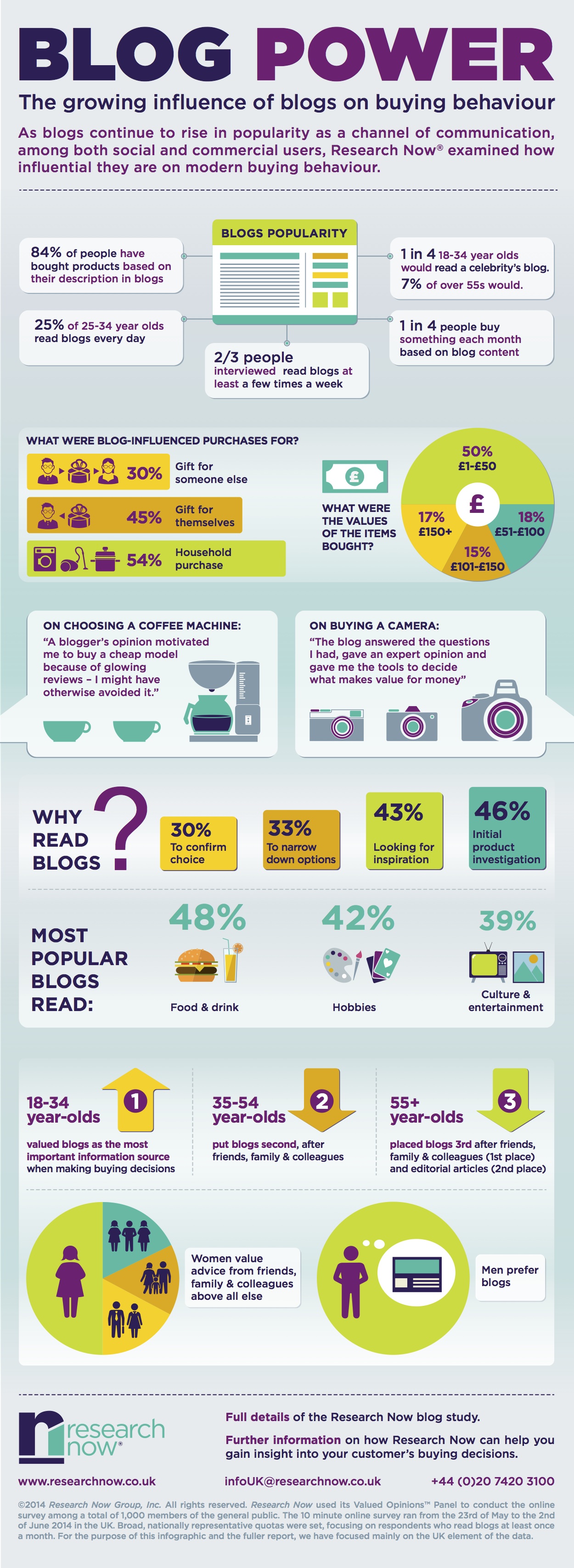 The power of blogs in influencing consumer purchase decisions is stronger than you might realize. According to data from a research study conducted by Research Now, nearly nine in 10 consumers (84%) make purchases after reading about a product or service on a blog. Among consumers between the ages of 18-34, blogs ranked as the most important source of information to make buying decisions. Among consumers between the ages of 35-54, blogs ranked as the second most important source behind friends, family, and colleagues. Even older consumers (55 and older) value blogs when making purchase decisions ranking them third in terms of importance behind friends, family, and colleagues and editorial articles.
The power of blogs in influencing consumer purchase decisions is stronger than you might realize. According to data from a research study conducted by Research Now, nearly nine in 10 consumers (84%) make purchases after reading about a product or service on a blog. Among consumers between the ages of 18-34, blogs ranked as the most important source of information to make buying decisions. Among consumers between the ages of 35-54, blogs ranked as the second most important source behind friends, family, and colleagues. Even older consumers (55 and older) value blogs when making purchase decisions ranking them third in terms of importance behind friends, family, and colleagues and editorial articles.
For brands, this data is critical. The research found that blogs influence household purchase decisions for 54% of the survey respondents, gifts that consumers are buying for themselves (45%), and gifts they’re buying for other people (30%). In fact, 25% of respondents indicated that they buy something each month based on blog content!
Consumers are turning to blogs for specific reasons as they travel through the path to making a purchase. Nearly one in two (46%) use blogs for initial product investigation, and 43% use blogs for inspiration. One in three consumers (33%) use blogs to narrow down their purchase options while 30% use blogs to confirm their purchase choices. In other words, blogs play a role at every stop along the marketing and sales funnel.
Blog advertising (display and text) as well as sponsored posts offer excellent ways for brands to get in front of consumers on blogs. However, brands are missing key opportunities to seize useful sponsored content opportunities. Popular bloggers and smaller, niche bloggers with coveted audiences receive dozens or even hundreds of blog advertising and sponsored post pitches every day. Most of these pitches are templated email messages sent to many bloggers which go directly to the email trash can. When brands do successfully connect with a blogger, they often provide self-promotional content that is either irrelevant to the audience or so self-serving that it would damage the blog’s reputation and audience’s trust in the blog too much to publish it. Trust me. I get these pitches for my blog every day and there are very few that I actually respond to.
Brands that invest the time into finding the right blogs to connect with their target audiences, craft pitches that are exclusively for those individual blogs, and provide useful, meaningful content that the blog’s audience would be interested in will reap the rewards. Blog are not dead. For brands, they’re more powerful than ever but they have to be leveraged correctly.
You can see more data from the study in the infographic from Research Now below.

Do you have a blog strategy in place for your brand?
Image: Svilen Milev
 It’s hard to find a company that doesn’t offer biographies of current employees these days, and sometimes they seem indistinguishable.
It’s hard to find a company that doesn’t offer biographies of current employees these days, and sometimes they seem indistinguishable. Many B2B companies use case studies to help promote their skills and / or products.
Many B2B companies use case studies to help promote their skills and / or products. For consumer product brands that offer their products for sale in the United States, Black Friday and Cyber Monday are very important sales days. For years, brand marketers have reduced prices, opened retail locations early, and invested heavily in advertising to get a jump on holiday shopping sales. However, consumer behaviors are changing, and brand marketers have to shift their marketing strategies to meet changing consumer demands.
For consumer product brands that offer their products for sale in the United States, Black Friday and Cyber Monday are very important sales days. For years, brand marketers have reduced prices, opened retail locations early, and invested heavily in advertising to get a jump on holiday shopping sales. However, consumer behaviors are changing, and brand marketers have to shift their marketing strategies to meet changing consumer demands.